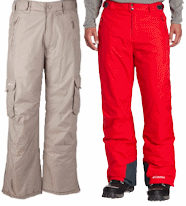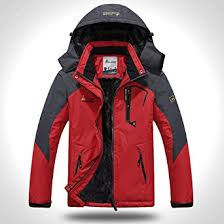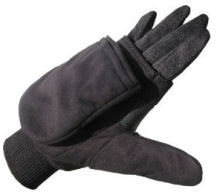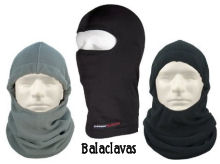
Winter Tent Camping Scene
Dress for Winter Camping – The How’s and Why’s
Extreme Cold Weather Clothing Guide
Hats, Gloves, Socks, Boots, and Layers
Most people know to dress in layers for cold weather – it’s an old adage, but with regards to winter camping it is a lot more than just being able to put on or take off layers as needed.
Maintaining maximum dead-air space, and moisture control are the two primary purposes of dressing in layers.
Camping activities range from periods of heat-generating exertion to heat-sapping inactivity, and each layer of clothes serves a function related to this.
It’s all about the layers…
The Three Clothing Layers
• Inner – Wicking • Middle – Warmth • Outer – Wind and Moisture Barrier
*Cotton is the worst material for winter and cold weather clothing. Try to avoid it – especially for undergarments like t-shirts or long johns. It not only absorbs and retains moisture, (body perspiration), but it also compresses when wet – losing all of its “dead-air,” (space between fabric fibers), heat retention capabilities.
Clothing does not keep you warm based purely on its thickness or bulk – it does it because of the amount of “dead-air” space it contains. Heat transfers through solid materials, (like clothing fibers), a lot faster than through air.
The Basic Winter Camping Layers Tips
You can find the details below, but here are the basic concepts.
- Always wear a hat – a knit or watch cap type, not a tight fitting ball cap.
What Gus Wears: A Wool-knit watch hat or a Yukon-style hat.
Knit-type watch caps work great, but when it is really cold – nothing beats a Yukon like the ones below. - Wear at least 3 layers of clothes. An inner wicking layer like thermal underwear, a mid-layer of fleece or flannel, and a top layer that is wind and moisture-resistant. *experienced cold weather campers usually wear 4 layers, to have more control of what they need to take off or put on
Wicking baselayer
What Gus Wears:
Thermals may be an old-time idea, but as long as they are a synthetic fabric – they are hard to beat for warmth.
*for extreme cold, I will wear a second baselayer top over my thermal top.Middle Layer – Warmth
What Gus Wears:
A Merino Wool sweater or a hi-neck Zip-up fleece mid-layer for my torso. Both are lightweight and excellent warmth choices.*Except for high altitude extreme temperatures, I don’t wear a mid-layer on my legs. My outer-layer pants shown below are all that is needed.
Outer Layer – Warmth and Barrier Protection
What Gus Wears:
My outer-layer pants were an important choice. I wear thinsulated water and wind-resistant snowboarder-type pants. They are not bulky and are warmer than just shell pants outer layers.*Too many campers and hikers overlook the importance of the outer layer bottoms of their winter outfits. Jeans and khakis are not the best choice for winter camping wear – but they are the choice of too many campers that are otherwise dressed appropriately.
My “general camping” outer-layer jacket is a fleece mountaineer jacket. It has wind and water barrier protection, plus the warmth of fleece. - Cotton socks are not your friend! Wool socks are best, but a couple of pair of thick synthetic material socks will also work. Just make sure your feet are not so tight in your boots that heat-providing blood circulation is restricted.
What Gus Wears:
Merino Wool socks are my favorite choice. I wear a thin layer of inner synthetic socks with a second pair of Merion Wool socks. This combination keeps my feet warm – without making my feet too tight in my hiking boots.
- Mittens are much better than gloves. Even better than those thick ski-type gloves. *you can see a perfect choice – convertible mitten gloves, below
What Gus Wears:
Since I discovered Convertible Mitten Gloves, I have never gone back to regular gloves! The difference in how warm your fingers stay is amazing. I get the warmth of mittens and the dexterity of gloves. This is one investment you really should make.
- A ski mask-type face covering works great, but a head-to-neck balaclava will be one of the best cold-weather camping investments you will make. *see examples below
- And most importantly, don’t let yourself work up a sweat. Take off a layer or two when you feel the heat from exertion.
The Purpose of Winter Clothing Layers:
The Inner Layer
The inner layer is the wicking layer. Its purpose is to draw moisture away from your body. It is generally tight-fitting so that it will be in contact with your body sweat* and able to wick it away to the middle layer where it will evaporate.
It is very important that it is made of a non-collapsing material like; silk, wool, (yes, there are thin, soft, and light-weight wool fabrics), or synthetics, like; polypropylene, polyester, or the newer micro-tubular fabrics.
*Your body sweats even when you don’t know it. It’s called “insensible sweat” and occurs even when you are just sitting or sleeping.
Inner Layer clothing:
Typical – Thermal, (insulated), long underwear
- The insulated aspect is the fabric weave, and the fabric itself. Thermal underwear is woven so that the fabric forms a grid design that creates a lot of “dead-air” space which will trap and retain your body heat. Of course, the fabric should be non-cotton and is usually a synthetic fiber, like polyester.
- Available in colors, and sized and fitted for men, women, or children. Price range: $15 – $30 per set
- *Note: All links are my own Amazon affiliate links – which I only use to recommend good quality camping Gear – Gus. Even if you are not ready to buy – they will give you valuable comparison information.
Regardless of brand and style – (Merino and tropical-weight wool are also excellent choices), remember that the inner layer’s purpose is to pull moisture away from the body, and, help retain your body heat. It does not have to be thermal, but it should not be extremely loose-fitting, and it should not be cotton.
Recommended: A Merino Wool Baselayer is the top choice, followed by Columbia and Under Armour. *There are examples of both in the links below.
Middle Layer Clothing – warmth
The most important factor in choosing the middle layer of clothing is that it has a high capacity for “dead-air” spaces that will slow down the body’s heat loss. Wool is a good example of this. The “curliness” of wool fibers does double duty; it creates a lot of air voids within the fabric of the garment, and it has the strength to resist crushing and compacting – which would eliminate those air voids.
Types of Middle Warmth-layer materials:
- Wool – gets its insulating quality from the three-dimensional elastic, wavy crimp in the fibers that traps air between them. The cloth weave of some wool clothing can be as much as 60-80% air – which is excellent for heat retention. Wool can also absorb small amounts of moisture without feeling really wet – because the water “disappears” into the fiber spaces.
One disadvantage of wool is that it can be very heavy when wet, and releases moisture slowly, but when excess water is wrung out, even wet wool has a minimum chilling effect. Wool can be woven in very tight weaves that are quite wind-resistant. Coarse woven wool can be itchy against the skin and some people are allergic to it.
- Fleece or Pile fabrics – are synthetic materials, often made of a plastic (polyester, polyolefin, polypropylene, etc.), fiber. These fabrics have insulating qualities similar to wool but are more hydrophobic, (less water absorbent), which means they hold less water (than wool) and dry more quickly.
The pile is available in different weights, (thicknesses), with different amounts of loft and insulation. While good as a middle warmth layer, pile, (fleece), is not very wind or water-resistant – making it a poor choice for an outer layer.
- New Microfilament Polypropylene and other Hydrophobic fabrics – the development of new “microfilament” fabrics made with synthetic plastic fibers which offer exceptional “dead-air” space, (similar or equal to wool), and do not absorb water, has created many new warmth-layer choices. Most of the major camping gear and clothing manufacturers now have their own proprietary materials.
For middle warmth-layer choices – think of fleece or wool; pull-overs, sweaters, vests, or even jackets as a choice for the middle warmth layer.
It is also typical to have two middle-layer garments – a medium to the heavy-weight shirt, (like a flannel camping shirt), over the inner layer, and under the fleece or wool outer-middle layer.
Recommended: See recommended top-line middle layer garmemts
Outer Layer Winter Clothing – warmth and barrier
The primary purpose of the outer clothing layer – in most cases, is to be a wind and moisture barrier. Of course, it needs to provide warmth also,(dependent on temperature extremes), but even then its outer layer should be a barrier layer. Like Gortex, or other wind and water-repellent fabrics.
In the case of extreme warming needs, it is also usually the bulkiest layer and the first and easiest to be donned or removed.
In the case of mild winter temperatures it can be as thin and light-weight as a simple windbreaker material, and in colder temperatures as thick and bulky as a full-blown hooded parka.
Types of Outer Layer Winter dress choices:
- Regarding insulating materials – down is considered the best. But it has the drawback of being the worst when it gets wet – so a down jacket or coat must be enclosed in a water-resistant/repellent barrier layer. Wool, and the newer microfilament fabrics, (discussed above), are excellent choices, both for warmth and moisture reasons.
- Fleece or Pile as insulating layers, (as discussed above), are dependent on temperature requirements.
They are good insulators, but usually not sufficient for extreme temperatures.
- New Microfilament and tubular-fiber materials have made great breakthroughs in lightweight extreme temperature capabilities that are rivaling the heat retention abilities of down.
Outer layer coats and jackets, although a highly personal choice, are almost always dependent are camping environments, and temperature needs when considering how to dress for winter camping.
Recommended: See recommended top-line outer layer jackets and coats
Tip:
When it is time to get out of those great cold-weather clothes and into your tent, there is one more choice to consider.
For a really cozy warm tent, you can step up to the next level with a safe catalytic tent heater. They don’t use a flame for heat so there are no dangerous carbon monoxide fumes to worry about, and they come in sizes for large and small tents.
You can see our review of the two best fume-free catalytic heaters below:
- *Note: The example links show details and availability on Amazon. Even if you are not ready to buy – they will give you valuable comparison information.
You might also like:
|
Was this helpful? Help us share Campingwithgus.com by giving us a “Like” |
 |
Related Topics:
- Top 3 Best Selling Winter Hiking Boots
- How to Pick the Best Sleeping Bag
- How to Pick the Best Camping Stove
- Camping and Campfire Cookware – What do you need
- How to Pick Campfire Coffee Pot
- How to Pick Gloves for Campfire Cooking
A note about shopping links and referrals: Most of the product links here are referral links, and Gus does get a few pennies commission, (trust me, it is pennies – no 75% commission ebooks here!), which does not affect your price at all. Plus the links have been researched to provide the cheapest prices available online so you don’t have to spend hours searching through the thousands of possibilities.
![]()
| Contact Gus | Privacy Policy | Site Map | |























